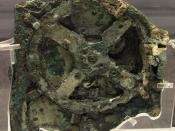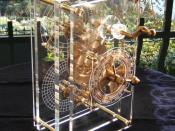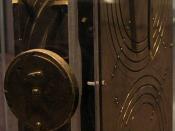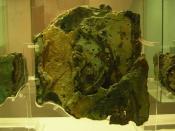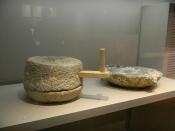The Antikythera mechanism has been one of the most intriguing finds of the twentieth century. It has shed light on the true complexity of ancient technology and made us rethink our perceptions about Greek mechanics. All from a lump of bronze abandoned in an Athens museum thought to be of little value.
The antikythera mechanism was discovered by a group of Greek sponge divers in 1901 off the coast of antikythera. However, they were not searching for ancient wrecks at all, but rather were blown off course by a freak Mediterranean storm. Once the storm abated, the captain decided to send a diver down to make use of the time.
Once the diver descended into the bay, he came across an ancient wreck that he mistakenly believed to be a heap of bodies. Mistaking the heads of statues poking above the sandy bottom as corpses, he surfaced in a panic.
However, the captain, undaunted by his divers report, sent another diver to investigate the site. The second diver correctly identified the ÃÂheadsÃÂ as statues.
The captain and crew returned to the Greek mainland and did not report the wreck for an entire year. Some have speculated they returned several times to loot the site and sell the recovered artifacts on the Alexandrian antiquities market. Regardless, they reported the find to the Greek Government in 1901 and were commissioned to take part in the retrieval.
During the course of the excavation the antikythera mechanism received little attention. The true complexity of it was not known as it was in a state of heavy encrustation and believed to be a simple astrolabe, a common navigational tool found in many in wrecks. It was also overshadowed by numerous other finds from the site, including the well known ÃÂantikythera youthÃÂ and ÃÂphilosophers headÃÂ that now reside in the Athens Museum. After recovering more than 30 statues of marble and bronze, and several pieces of fine glassware, the excavation was terminated after the death of two divers. The antikythera mechanism, itself, was taken to the Athens Museum and left in a storeroom not on display to the public.
The wreck sat unexplored until 1959 when Peter Throckmorton and George Bass undertook a new examination of the site. Although they did not retrieve any significant artifacts, they did complete a survey of the site.
Several planks of wood from the ship itself were recovered, preserved by the sandy bottom of the sea, that have allowed up to reconstruct the ship with an adequate degree of accuracy. They ship was built in a shell first manner, with the outer planking being laid before the internal supports, directly opposite of the manner of modern ship construction. However, there is precedent for this form of construction in the later Nemi Barges. Although the antikythera ship was much smaller and less ornate than the imperial Nemi barges, the construction method was similar. This leads us to believe that this form of construction may have been prevalent throughout the ancient world.
Based upon the finds at the site, a hypothetical route for the ship had been determined. It is believed that it left either Rome of Brundisium, traveled to Alexandria, then Rhodes. After loading cargo at Rhodes, it is believed that the ship encountered an unusually strong storm, much like the storm that blew the sponge fisherman off course and led to the wrecks discovery, and sank. Of course, this cannot be known with any certainty as ships often carried diverse cargoes and the nature of maritime trade facilitates a ship loading various goods far from their place of manufacture at trading centers around the Mediterranean.
Since the dating techniques used at the time of the initial examination of the site had not yet progressed to their modern state of relative certainty, there was a great variation on the dating of the wreck. Some believed the wreck to be the Greek classical period, while others placed it firmly in the late Roman period. However, with advanced in pottery chronology, the site has since been dated to 70-80 BCE. This places it wall after the classical period, in the late Hellenistic or early Roman period.
The conclusion which much is reached from an examination of the antikythera wreck is that Greek and Roman trade was far more complex than had been previously assumed. The quality and quantity of goods found at the antikythera wreck must not be seen as an anomaly, but rather as a standard cargo. The wreck supplied us with a wealth of information about ancient shipbuilding techniques as well as the quality of ancient luxury goods.
Bibliography:Wright, M T. (2005). "The Antikythera Mechanism: a New Gearing Scheme". Bulletin of the Scientific Instrument Society 85 (June 2005): 2-7Wright, M T. (2005). "The Antikythera Mechanism and the early history of the Moon Phase Display". Antiquarian Horology 29 (3 (March 2006)): 319 ÃÂ 329Price, D. de S. (1955). "Clockwork before the Clock (a)". Horological Journal 97: 811-813.
Price, D. de S. (1975). "Gears from the Greeks: The Antkythera Mechanism ÃÂ A Calendar Computer from ca 80BC". Trans Am Philos. Soc., New Series 64:7
